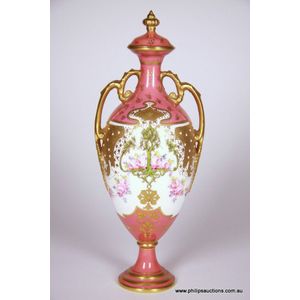Sevres-style Rustic Family Vase
You must be a subscriber, and be logged in to view price and dealer details.
Subscribe Now to view actual auction price for this item
When you subscribe, you have the option of setting the currency in which to display prices to $Au, $US, $NZ or Stg.
- Rustic - Rustic is defined as "of, relating to, or typical of country life or country people", and the items illustrated in this price guide accord with that definition.
But in the 18th and 19th century "rustic furniture" had a narrower definition. It referred to furniture where the framework was carved or moulded to resemble tree trunks and branches, and was usually for outdoor use. Rustic furniture was made in cast iron, wood, terracootta and concrete. Much of the Coalbrookdale company's cast iron furniture was of rustic design. - Verso - Verso is the "back" side of a sheet of paper, art work, coin or medal. The front side is "recto".
- Gilding - Gilding is a method of ornamentation whereby a thin sheet of gold metal is applied to items made of wood, leather, ceramics, glass and silver for decorative purposes.
For furniture including mirrors, the sheet of gold is usually applied over a coating of gesso. Gesso is a mixture of plaster of Paris and gypsum mixed with water and then applied to the carved wooden frames of mirrors and picture frames as a base for applying the gold leaf. After numerous coats of gesso have been applied, allowed to dry and then sanded a coat of "bole", a usually red coloured mixture of clay and glue is brushed on and allowed to dry, after which the gold leaf is applied. Over time parts of the gilding will rub off so the base colour can be seen. In water gilding, this was generally a blue colour, while in oil gilding, the under layer was often yellow. In Victorian times, gilders frequently used red as a pigment beneath the gold leaf.
Metal was often gilded by a process known as fire gilding. Gold mixed with mercury was applied and heated, causing the mercury to evaporate, the long-term effect of which was to kill or disable the craftsman or woman from mercury poisoning. The pursuit of beauty has claimed many victims, not the least of which were the artists who made those pieces so highly sought after today.
This item has been included into following indexes:
-
Sevres (France) and Sevres style, items
- house wares 265
- vases and urns 215
Visually similar items

19th century Doulton Lambeth stoneware vase, with a spreading lip above an ovoid body, decorated with anthemion incised motifs in the Art Nouveau taste, in tones of pale blue and green, impressed factory marks to base, height 28 cm

A large Sevres pattern pink ground vase painted with lovers, French, circa 1900 82 cm high

A very large Sevres pattern porcelain blue ground vase, French, circa 1900 80 cm high

An Edwardian Royal Crown Derby vase with cover. 1901, the slender ovoid pedestal vase with a small trumpet neck, a scrolling leaf form gilded handles and a domed cover, decorated with a deep shaped border of pink roses and other blooms within a green bower
